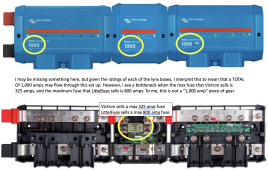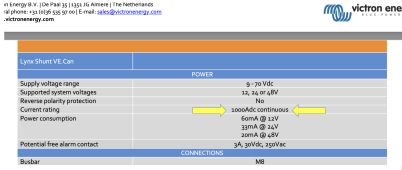BillCaswell
New Member
- Joined
- Jan 10, 2020
- Messages
- 78
You asked two questions in the original post, is that exactly what you sent to Victron?Check the initial posting in this thread.
verbatimYou asked two questions in the original post, is that exactly what you sent to Victron?
Charitable interpretation is they misunderstood the question.verbatim
I get that the total throughput can not exceed 1,000 amps, which may be a combination of, for example two 500 amp connections going into the lynx power in. Both sources = 500 amp each x 2 to give 1,000amps. But if the max fuse that one can find is 800 amp, per advice from Victron, then how is this a 1,000 amp system?It is common for a busbar to have a total rating that is different than the per-connection rating.
With a 4-lug 1000A busbar, you can not have 1000A going in on two of the lugs and 1000A going out of two of the lugs, but you could have 500A going into two lugs and 500A coming out of two lugs.


Simple.... You can have as much as 1000amp going in and out. However, all 1000A will not be through one lug, it will be split between lugs.how is this a 1,000 amp system?
That is 1000 amps from 4 connections per the photo above. 250 amps per connection so buy 250 amp fuses to make your connections. I personally used 300 amp Mega fuses.I get that the total throughput can not exceed 1,000 amps, which may be a combination of, for example two 500 amp connections going into the lynx power in. Both sources = 500 amp each x 2 to give 1,000amps. But if the max fuse that one can find is 800 amp, per advice from Victron, then how is this a 1,000 amp system?
View attachment 131317View attachment 131316
I get this. I am focused on the lynx shunt not supporting more than an 800amp fuse. That to me is the bottleneck. Won't the fuse blow when you exceed the current rating of the fuse, in this case using the Victron fuse of 325 amps, or a Littelfuse @800amp.Simple.... You can have as much as 1000amp going in and out. However, all 1000A will not be through one lug, it will be split between lugs.
As I said above, I have seen other busbars where the total current capacity is greater than the current rating for any one connection.
Yes, I understand. I am referring to the lynx shunt. See the middle unit in my pictures.That is 1000 amps from 4 connections per the photo above. 250 amps per connection so buy 250 amp fuses to make your connections. I personally used 300 amp Mega fuses.
You do not have to worry about that fuse because it’s just fusing the small amount of power required by the shunt itself. If you look closely I chose to use the Victron smart shunt and mine is attached. If you’re using this for a battery bank to an inverter you are paying a lot for stuff you do not need. You actually only need a Victron Power in ( maybe 2 of them depending on how many batteries) and a smart shunt. You do not need a power in, Lynx shunt and a Lynx distributor.I get this. I am focused on the lynx shunt not supporting more than an 800amp fuse. That to me is the bottleneck. Won't the fuse blow when you exceed the current rating of the fuse, in this case using the Victron fuse of 325 amps, or a Littelfuse @800amp.
Yes, I understand. I am referring to the lynx shunt. See the middle unit in my pictures.
Got it. I was not following before sorry. Yes. When the shunt is there the system's continuous current is limited to the fuse size.I get this. I am focused on the lynx shunt not supporting more than an 800amp fuse. That to me is the bottleneck. Won't the fuse blow when you exceed the current rating of the fuse, in this case using the Victron fuse of 325 amps, or a Littelfuse @800amp.
That fuse in the lynx shunt is going to see 100% of the system current.The positive buss is passed straight through to the power in and distributor so no fusing needed. Same with the negative except the shunt sits in the middle still no fusing needed. The only fused thing is the power needed to operate the shunt and it’s software.
IncorrectThat fuse in the lynx shunt is going to see 100% of the system current.
That is totally incorrect see my explanation above. I have one and so do hundreds of others. No, absolutely no shunt is fused for the loads or rated current flow. The only fused connection for ANY shunt is for the power lead to power the shunt itself.Got it. I was not following before sorry. Yes. When the shunt is there the system's continuous current is limited to the fuse size.


